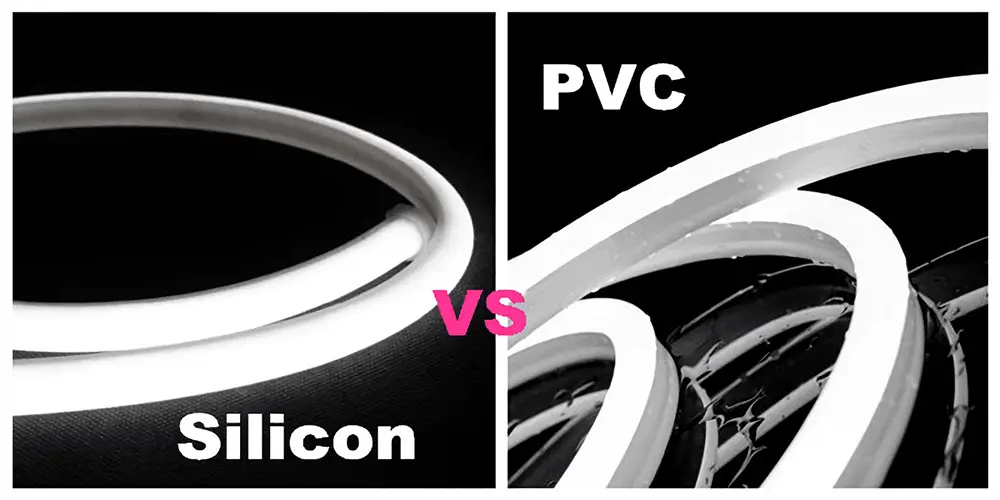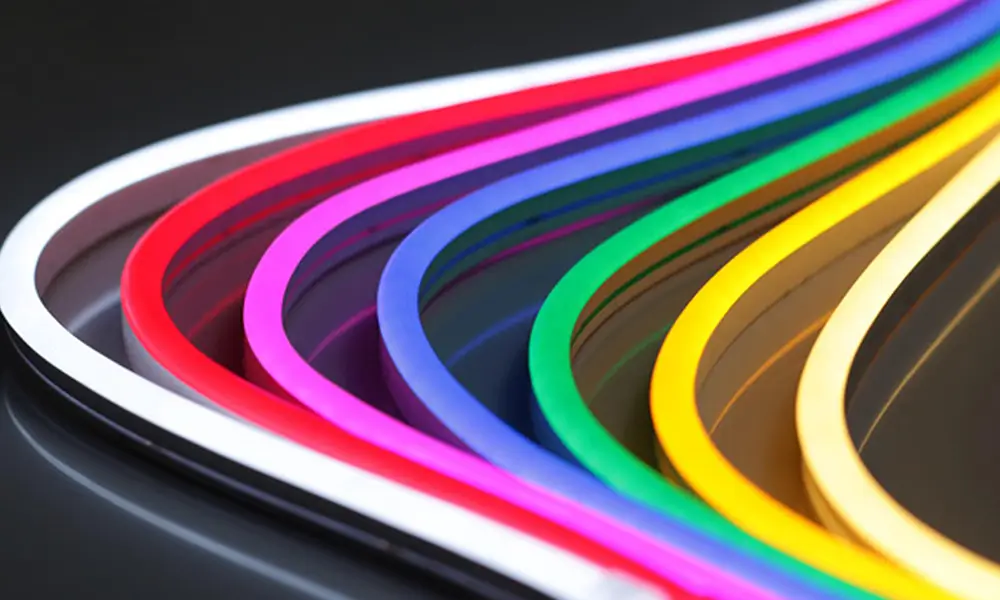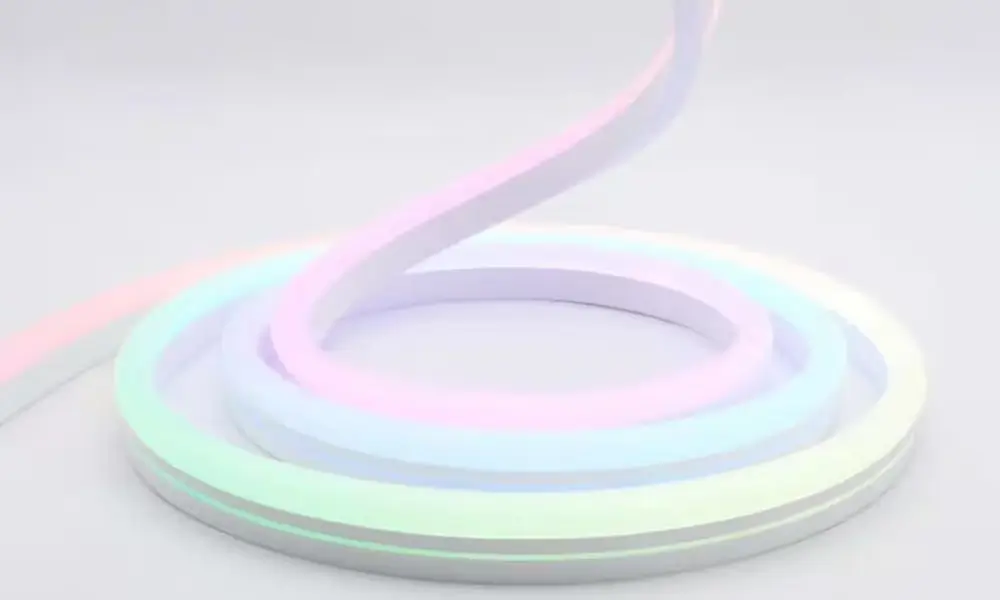
LED Neon Flex is a popular choice for lighting projects due to its versatility and eye-catching luminous effect. However, when choosing LED Neon Flex, we have seen that there are raw materials PVC and Silicone, it is very important to understand the difference between PVC vs Silicone LED neon flex.
In this article, we will deeply discuss the material characteristics of PVC and silicone LED neon flex, what are their differences, advantages and disadvantages, differences, and how to correctly choose a suitable LED neon tube.
What is the Material of PVC?
PVC (polyvinyl chloride) exhibits durability, flexibility, and cost-effectiveness as a synthetic plastic polymer. Various industries widely employ it, including its application in lighting products.
What is the Material of Silicone?
Silicone, a synthetic material, derives from silicon, oxygen, hydrogen, and carbon. It has excellent temperature resistance, UV stability, and flexibility. Silicones, commonly used in applications requiring high-performance materials, now also find application in lighting products.
What is PVC LED Neon Tube? Pros and Cons?
PVC LED neon tube consists of PVC material wrapping and utilizes LED strip lights as its main light source.
Its advantages are affordable, easy to install, and available in a variety of colors. However, PVC may be less resistant to extreme temperatures outdoors and will fade over time when exposed to direct sunlight.

What is Silicone LED Neon Tube? Pros and Cons?
Silicone LED neon flex feature a silicone material that covers the LED strip lights. Silicone provides excellent durability, UV resistance, and better heat dissipation.
It is ideal for outdoor applications and provides long-lasting color retention, will not change color due to exposure to the sun, and will not become brittle over time. As a result, high-end specialty lighting projects often prefer Silicone LED Neon Flex over PVC alternatives. But its price will be a little more expensive than PVC.

Main Differences Between PVC vs Silicone LED Neon Flex
The following is a comparison between PVC neon flex and silicone neon flex, in terms of raw material performance and other aspects. This will help you choose the most suitable product.
- Cost: PVC LED neon flex is more cost-effective, while silicone neon flex is more expensive.
- Performance: Silicone LED neon flex has better UV resistance and color retention.
- Heat dissipation: PVC LED neon flex is generally not heat resistant compared to silicone LED neon flex.
- Flexibility: Silicone is more flexible and bends better than PVC LED neon flex.
- Durability: Silicone LED neon flex has increased durability and can withstand extreme temperatures. PVC LED neon tends to fade easily in direct sunlight, while silicone will retain its color.
- Color Temperature: PVC LED neon flex is available in a variety of colors.
- Light Diffusion: Silicone LED neon flex has excellent light diffusion capabilities.
- Lifespan: Silicone LED neon flex tends to have a longer lifespan than PVC LED neon flex.
Which is Better? PVC Neon Flex Vs Silicone LED Neon Flex?
The choice between PVC and Silicone LED Neon Flex depends on your lighting project. PVC would be more affordable, but we think it’s only suitable for indoor applications.
Silicone neon tubes are suitable for indoor and outdoor use. And it excels in outdoor environments with better durability and UV resistance. But it will be slightly more expensive.
All in all, this depends entirely on your needs, mainly depending on the positioning of your lighting project. Of course, both products have advantages and disadvantages, you just need to choose the most suitable product according to your needs.
How to Identify PVC LED Neon Flex Vs Silicone LED Neon Flex?
Check the product specifications or inquire with the supplier. PVC Neon Tubes usually come in a wider range of colors, while silicone LED Neon Lights are often advertised for their UV resistance and durability.
Summary
There are clear advantages and considerations for the PVC vs silicone LED neon flex. PVC is cost-effective and comes in a variety of colors, while silicone offers better durability, UV resistance, and color retention.
Finally, how to choose depends on your specific requirements and application needs. Also evaluating factors such as budget, outdoor exposure, life expectancy, and temperature changes will help you make an informed decision when purchasing an LED Neon Flex.
FAQs
Silicone LED Neon Flex is generally more flexible than PVC LED Neon Flex. Its silicone material allows for easier bending and shaping around curved surfaces.
Two LED Neon Flex is known for its durability. But the Silicone LED Neon Flex is perfect for outdoor use, it won’t yellow and harden over time, and its rigid structure makes it impact and deformation resistant.
Compared with PVC LED neon lights, silicone LED neon lights usually have better UV resistance, mainly because its raw material is silicone, so it is not easy to be discolored or damaged by prolonged exposure to sunlight.
Both PVC and Silicone LED Neon Flex are easy to install. You can choose matching accessories, or go to the hardware store to buy it yourself. However, the flexibility of the silicone LED Neon Flex may make it easier to handle and shape complex designs.
Yes, both PVC and Silicone LED Neon Flex allows you to cut it yourself. You can spot the designated cut points so you just need to get the length you need for your particular installation, just remember to always cut along the cut points.
